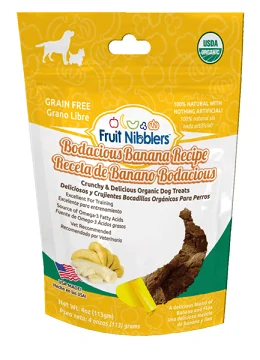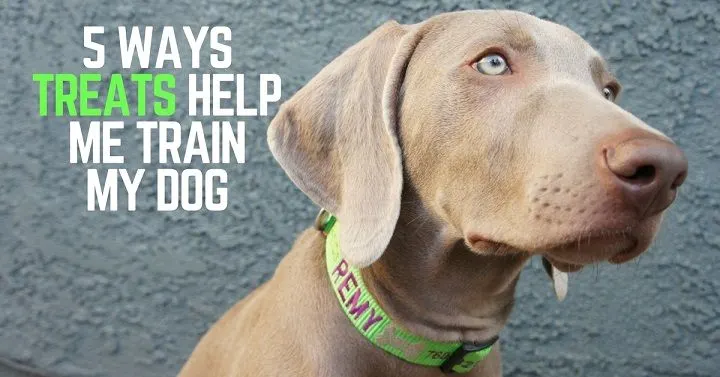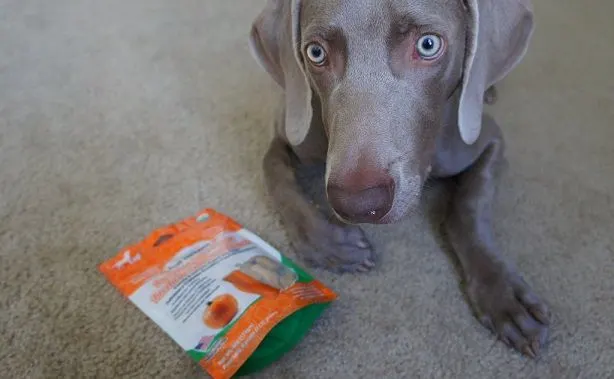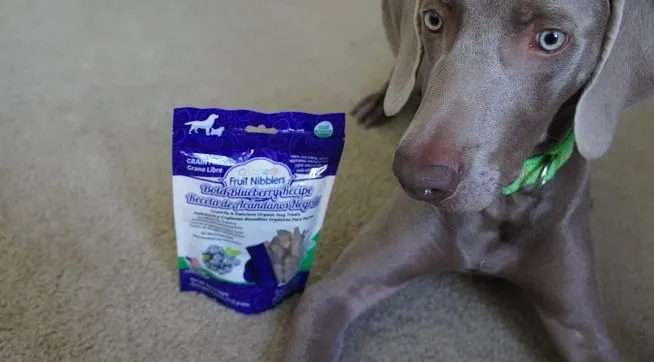Note: This post is sponsored by Fruit Nibblers and Pipeline Pet Products.
I tell my puppy “NO!” plenty of times per day (probably 50 times, let’s be honest).
Sometimes “No!” is just the easiest way to get my point across in the moment, and it works.
For example, I see Remy about to pick up my shoe. I tell him “No” and usually it stops him.
But what it doesn’t do is stop him from attempting to steal my shoe again in 10 minutes or from stealing my shoe the next day.
So, the following are some examples where Fruit Nibblers treats have helped me reinforce the behavior I want so my weimaraner puppy will be more likely to repeat that behavior on his own in the future.
This is so much more effective long term than constant “nagging.” And it allows me to save my Mama Bear “NO’s!” for when they’re really needed—and yes, they’re needed!
Enter my Fruit Nibblers treats giveaway HERE (10 winners)
5 examples where treats help me train my puppy
1. Teaching self-control and respecting space.
Remy is a pup who is very much “in your business” and rude. He has big, clumsy paws and he likes to “punch” and grab at people for attention. Not good.
I can tell him “no” all I want. Sometimes I even shove him away. He thinks this is great game!
What truly works is to have treats in my pocket and to completely ignore my puppy until he backs away, sits or lies down. Then he gets the treat.
You’d think this might be a difficult concept for a young dog to learn, but it seriously took Remy one 2-minute session and he figured it out.
He gives me space. I give a treat.
See my post: How to teach a puppy the word Off
2. Not pulling on walks.
I have all sorts of training collars designed to decrease my puppy’s pulling.
[quote_right]Treats are oh so helpful when dogs are still learning.[/quote_right]They all work in their own ways to an extent, but the only time my puppy truly walks nicely on a leash is when I’m carrying treats and we’re both focused on practicing “heel.”
Obviously we all want our dogs to walk nicely without treats, but treats are oh so helpful when dogs are still learning and you need anything to make sure you’re more interesting than everything else.
3. For taking away bully sticks or rawhides.
I make a point to approach my puppy (so he can see me), remove his bully stick or rawhide, give him a treat and then give the bully stick right back. I might hold the stick for a second. “Oh, what a nice stick. What a good boy!” Then I give him a treat. And then I give him the bully stick back.
My puppy learns that I can take away items and it’s no big deal. Usually treats are involved. Awesome!
4. Reinforcing patience and calm behavior around my other dog.
I like to have both dogs sit in front of me, and then I give them treats one after the other for sitting patiently. “Oh what a good boy, Ace! Oh what a good boy, Remy!”
They learn not to be pushy and to wait their turns. It also helps them associate treats and good things with each other!
5. Reinforcing calm behavior when touching my puppy’s feet.
I have a squirmy, mouthy puppy who likes to bite and wiggle when I hold him. Thankfully, he’s not aggressive about it, just completely wiggly and out of control. So, treats are helpful for teaching my puppy good things happen if he can just sit still and let me touch his feet, his toenails, his collar or his teeth.
This is very challenging for Remy, but it all goes back to my first example of teaching self-control. My puppy is always going to have a LOT of energy (God help us), so teaching him how to manage that energy is very important.
Other examples where treats are helpful:
[check_list]
- Rewarding my dog for going in his kennel
- Rewarding him for lying down calmly in the living room while we watch TV
- Rewarding him for focusing on me in public, like at a coffee shop or when we have visitors over and he’s on a leash
- Coming when called!
- Helping my puppy focus (sit/stay/watch) during photos
[/check_list]
Do you need some treats after reading this?
I hope you’ll check out Fruit Nibblers, a sponsor of my blog.
*Also, please share this post on Facebook or email it to someone it would help. Thank you!
Do you have any other examples where you use treats for training?
Let me know in the comments.





Matthew
Monday 5th of September 2016
Good article. I myself have used treats to stop negative behavior from the dog. And it works beautifully!
Sandy Weinstein
Saturday 27th of August 2016
my girls would love these, they love all treats. i like they are soft, now that they cant have really hard treats anymore. i say no, but the girls understand, uh, uh better. i do use little training treats for walks, and training. i try to limit the amount of treats they get to keep their weight ideal. when i give them treats, i try to remember to ask them to do something, like sit, lie down, shake, come, etc. i also put treats in a toy when i leave the house to give them something to do.
Kathryn
Wednesday 24th of August 2016
Our 8 y/o Llasa Apsa mix adopted doggie is generally quite well behaved. I have two issues that I could use some advice with though - related to treats. He jumps up on people too easily, and he insists on stop/start/stop/start walks with sniffs and pees every minute it seems. I'd like him to get a bit more exercise than this by keeping up the pace, at least for a good stretch. When should I give a treat in both these instances? Lindsay your newsletters are a wonderful help - thank you so much!!
Lindsay Stordahl
Thursday 25th of August 2016
With the walks, I would just keep on moving so he has to follow you. Maybe jog or run a bit so he's interested. You could also carry treats and work on "watch me" to get him to pay attention. I can't remember who said this but one trainer said, "You have to be more interesting than dirt!"
With the jumping, that's something I'm working on with Remy as well. With him, it's a combination of ignoring the jumping, sometimes using a firm NO if he's jumping on other people and rewarding him for sitting, which is when treats are handy. What have you tried with your dog?
Sharon
Wednesday 24th of August 2016
We have 2 dogs of our own, and foster for Home for Good Dogs. We often have 2 fosters at a time. They are brought to NJ from kill shelters in GA & SC. Many of them do not know their names, and have had to fight for every morsel they got to eat. I use treats to teach them their names. They all sit in the kitchen and I treat each dog in turn, starting with our alpha, saying their names as I do so. Of course I am watchful for any signs of aggression while doing this but have not had a problem. It also helps them to learn to wait for their turn.
Lindsay Stordahl
Thursday 25th of August 2016
Aww, I'm so glad to hear you are fostering dogs.
KL
Wednesday 24th of August 2016
Luring - learning a finish from scratch can be kind of a tough concept for a puppy. So we used a treat to lure them to swing from a "front" to a finish right or left. Now I can point at my left side and as soon as she sees where my hand is, she'll trot over and sit in a heel, but using treats to help mark where she should end up was very helpful. I also still use one occasionally for extra reinforcement on "hey this is where 'front' is, yes! GOOD GIRL!"
Lindsay Stordahl
Thursday 25th of August 2016
I do a lot of luring with treats as well.